Although Tucson area residents are aware of the things that people at LPL have done, they seldom identify them with LPL, but are more likely to think they’ve been done by “NASA” or “Kitt Peak.” In an attempt to raise awareness of LPL itself among community leaders, Dan Cavanagh, the Chair of the LPL External Advisory Board, arranged with the staff of U.S. Representative Ron Barber to have a set of Americ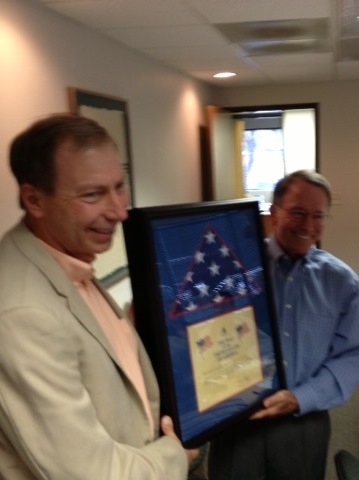 an flags flown over the U.S. Capitol on the 6th anniversary of the Phoenix Mars Lander launch (August 4). Dan then had these flags framed, and one each was presented at meetings of Visit Tucson (or Metropolitan Tucson Convention and Visitors Bureau), the Tucson Metropolitan Chamber of Commerce, and the Southern Arizona Leadership Council. In the photo, LPL Director Tim Swindle presents a flag to Mike Hammond, Chair of the Board of the Southern Arizona Leadership Council and President of Cushman and Wakefield/Picor.
an flags flown over the U.S. Capitol on the 6th anniversary of the Phoenix Mars Lander launch (August 4). Dan then had these flags framed, and one each was presented at meetings of Visit Tucson (or Metropolitan Tucson Convention and Visitors Bureau), the Tucson Metropolitan Chamber of Commerce, and the Southern Arizona Leadership Council. In the photo, LPL Director Tim Swindle presents a flag to Mike Hammond, Chair of the Board of the Southern Arizona Leadership Council and President of Cushman and Wakefield/Picor.
Department News
Orbiting Ray Bradbury's Mars: Biographical, Anthropological, Literary, Scientific and Other Perspectives
Edited by Gloria McMillan
McFarland Publishers, 2013.
by Gloria McMillan
It was my great honor to work with such a diverse group of writers on this groundbreaking collection. For the first time, a team of writers—several based at the Lunar and Planetary Lab and at the Kuiper Circle—has taken on a major American science fiction writer, from a full range of intellectual perspectives. Of course, our essayists include literary scholars, those who take an anthropological perspective, as well as film critics. One essayist is a Native American cultural studies professor who grew up reading The Martian Chronicles on and off the reservation, engaging with its allegory of settlers and native Martians. Two film critics tackle the media's adaptations of Bradbury's Martian texts. But beyond these comparatively expected voices on the legendary science fiction writer Ray Bradbury, we also have essays by space scientists and one aerospace engineer.
The names most familiar to those at the Lunar and Planetary Lab will be Peter Smith (Foreword) and the Planetary Science Institute's Bill Hartmann, who did cover art. We also have an essay from Kitt Peak's Chuck Dugan (NOAO Project Astro coordinator) who is in The Kuiper Circle. Two NASA scientists, Chris McKay and Carol Stoker, who worked on the Phoenix Mars Lander project with Peter Smith, wrote about "naming of names" on Mars—both their own activities and Bradbury's fictional "take" on giving Martian features new names. David Acklam, an aerospace engineer who is the Chair of the LPL Education and Public Outreach Kuiper Circle sub-comittee, wrote an essay based upon the realities of a human "invasion" of Mars, how Ray Bradbury predicted many of the challenges.
We hope you will find this as exciting as we did in writing this book. We will have a book launch event at LPL as part of the Tucson Festival of Books next March. But meanwhile...I have two links for those of you wishing to buy our collection:
Gloria McMillan, Ph.D., is a UA Associate (Research) and a member of the LPL Education and Public Outreach Kuiper Circle sub-comittee.
With regret, we forward the news that two long-time LPL staffers recently passed away.
Sam Clapp died on August 26, 2013. Sam was a project manager who worked on numerous spaceflight missions at LPL.
Ron James was an instrument maker/designer for LPL and Steward. He also passed away in August 2013.
LPL extends sincere condolences to the family and friends of Sam and Ron.
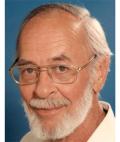
Former longtime LPL staff member Tom Teska passed away on March 15, 2013. Tom was the Manager for Mike Drake's Microprobe Lab from the early 1970s until 1998, when he retired.
Thomas M. Teska 79, passed away March 15, 2013. He was born in Chicago in 1933 to Emma and Thomas Teska. Surviving are his wife, Shelley Esterquest; son, John Teska; daughter, Jennifer Teska; grandson, Andrew and five stepchildren. Tom will be remembered by the many people with whom he shared his life in loving marriages, service to the Unitarian Church, and work at the University of Arizona. Through his hobbies, his gifts of charity, his good humor and his love, Tom gave so much to the people around him. He will be dearly missed.
A Memorial Service and Celebration of his life was held on Tuesday, March 26, 2013, at the Unitarian Universalist Church, 4831 E. 22nd St., Tucson. Memorial gifts in Tom's honor may be made to the charity of your choice.
Friends may view the obituary notice and sign a guest book here.
LPL often gets mentioned alongside our well known colleagues across Cherry Street in Steward Observatory. It’s not so often that we are mentioned alongside our other well known colleagues across University Boulevard who play in McKale Center, but we did manage to rate a mention in Sports Illustrated this year. Check it out!
The first two installments of what is hoped will be a regular series of talks referred to as the LPL Staff Colloquium were held on Thursday, February 7, and Tuesday, May 7.
In February, members of Professor Alfred McEwen's HiRISE team spoke about their work and roles on the mission project. The colloquium was held in the Sonett Building and refreshments were served.
The May colloquium featured a talk by OSIRIS-REx Principal Investigator Dante Lauretta and a tour of the Drake building and the meteorite collection housed there as part of the Southwest Meteorite Center.
Department Head and Director Tim Swindle initiated the Staff Colloquium Series to bring together personnel who are now located in three buildings (Kuiper, Sonett, and Drake) and do not have occasion often enough to meet colleagues on other projects and in other buildings.
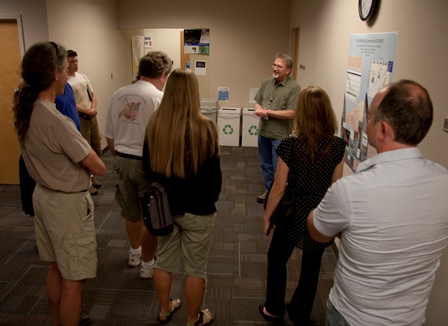
OSIRIS-REx Deputy PI Ed Beshore talks OCAMS during a tour of the Drake Building.
Congratulations to Terry Forrester, recipient of this year's LPL Staff Excellence Award, and kudos to Bert Orosco, cited as an honorable mention for the award.
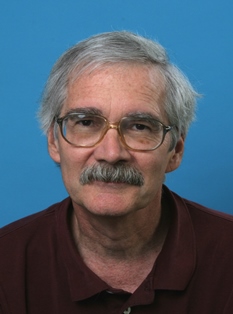 Terry Forrester is Systems Programmer Principal for HiRISE. He has a long history of service to The University of Arizona and to LPL, having begun his campus career in 1983. His colleagues recognized his service and dedication to his work, citing his availability at all hours (evenings and weekends!) to manage systems issues, coordinates maintenance schedules to minimize disruptions (even with remote HiRISE investigators located around the world). Terry was also praised for his ability to reconcile conflicting need, resolves user concerns cheerfully, and to follow-up on issues and installations. His co-workers also wrote that Terry is proactive about maintaining desktop computers for staff. His quick response time saves time and resources. Terry consistently goes beyond assigned duties by assisting with troubleshooting problems with other systems/computers.
Terry Forrester is Systems Programmer Principal for HiRISE. He has a long history of service to The University of Arizona and to LPL, having begun his campus career in 1983. His colleagues recognized his service and dedication to his work, citing his availability at all hours (evenings and weekends!) to manage systems issues, coordinates maintenance schedules to minimize disruptions (even with remote HiRISE investigators located around the world). Terry was also praised for his ability to reconcile conflicting need, resolves user concerns cheerfully, and to follow-up on issues and installations. His co-workers also wrote that Terry is proactive about maintaining desktop computers for staff. His quick response time saves time and resources. Terry consistently goes beyond assigned duties by assisting with troubleshooting problems with other systems/computers.
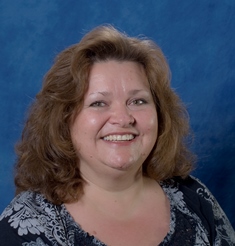 Compared to Terry, Bert Orosco has been at LPL a relatively short time. However, she has made her mark as the "face" of LPL in the Academic Office. Bert has distinguished herself with her creativity and has improved upon many office procedures, in addition to taking on new and ever-changing duties.
Compared to Terry, Bert Orosco has been at LPL a relatively short time. However, she has made her mark as the "face" of LPL in the Academic Office. Bert has distinguished herself with her creativity and has improved upon many office procedures, in addition to taking on new and ever-changing duties.
We appreciate all you do, Terry and Bert!
LPL alumna and E/PO lead for OSIRIS-REx, Anna Spitz, is one of the editors of a new volume (September 2013) from the University of Arizona Press.Encountering Life in the Universe: Ethical Foundations and Social Implications of Astrobiology, edited by Chris Impey, Anna H. Spitz, and William Stoeger, "examines the intersection of scientific research and socity to further explore the ethics of how to behave in a universe where much is unknown."
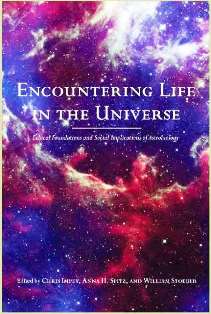
University of Arizona Press
September 2013
272 pp.
6 x 9
6 illustrations, 4 tables
ISBN 978-0-8165-2870-7 $39.95 paper
On Monday, March 25th, I had the honor to give two briefings on the OSIRIS-REx Asteroid Sample Return Mission to policy makers in Washington DC. OSIRIS-REx will visit asteroid 1999 RQ36, a carbon‐ and water‐rich object that is also one of the most potentially hazardous near‐Earth asteroids. This visit was scheduled in conjunction with the OSIRIS-REx Independent Assessment Review (IAR) on March 26th. The IAR is the last of a mission Preliminary Design Reviews and focuses on the credibility of the management, cost, and schedule plans.
My first stop of the day was at the White House Office of Science and Technology Policy (OSTP), where I was scheduled to give a Brown Bag lunchtime seminar on OSIRIS-REx. Jim Green, Director of NASA’s Planetary Science Division, Ed Beshore, OSIRIS-REx Deputy PI, and Shay Stautz, UA Vice President for Federal Relations joined me. We had a full house and several notable attendees including John Holdren, Director of OSTP, Philip Rubin, Principal Assistant Director for Science, and Tammy Dickinson, Senior Policy Analyst and our host. LPL alum Celinda Marsh (M.S., 2007), who now works at the Office of Management and Budget, was also able to join us. The meeting started out on a high note since I was able to pass around several fragments of the Chelyabinsk chondritic meteorite, which had exploded over Russia just one month prior to this presentation. Jim Green provided a nice overview of near-Earth objects and NASA’s wide-ranging efforts to study these bodies. I followed with a detailed overview of OSIRIS-REx, highlighting the exciting science and feed-forward technologies for the agency. Afterwards, Tammy let me know that everyone at OSTP was still talking about both the mission and the sample of Chelyabinsk that I left behind. It had several visitors that afternoon.
Later that afternoon, Shay and I traveled to Capitol Hill to provide a similar briefing for staff members of the House Science, Space, and Technology Committee. UA worked with both full committee staff director Chris Shank as well as with Arizona Representative David Schweikert to arrange that discussion. Our host for this briefing was J.T. Jezierski, Director of Coalitions and Member Services for the Science, Space, and Technology Committee. Staff representing six Committee Members attended. Again, the samples of Chelyabinsk provided an excellent introduction to the scientific value of studying asteroids and meteorites. This venue provided for a more intimate setting, with Shay and I sitting around a conference table with the staff members. I presented a general overview of asteroid science and discussed the OSIRIS-REx mission. The conversation was dynamic and covered a wide range of topics from Solar System to formation to asteroid impact hazards, and resources of near-Earth space. I also left behind a sample of Chelyabinsk for J.T. to pass on the Chairman Lamar Smith. The Chairman used the asteroid fragment to highlight the Chelyabinsk airburst event and kick-off the Full Committee Hearing - Threats from Space: A Review of Private Sector Efforts to Track and Mitigate 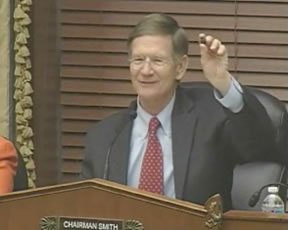 Asteroids and Meteors, Part II (see photo).
Asteroids and Meteors, Part II (see photo).
Overall, the visits to OSTP and Capitol Hill were very successful. Asteroid research and exploration is emerging as a top priority for the United States. This avenue of research is critical to understanding Solar System origins, assessing the asteroid impact threat, and pursuing resource development in near-Earth space.
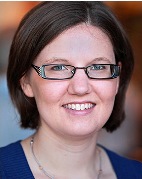
Kathryn M. Volk defended her dissertation titled "Dynamical Studies of the Kuiper Belt and the Centaurs" on April 1. Kat is a 2013 recipient of the Gerard P. Kuiper Memorial Award, presented each year to students of the Planetary Sciences who best exemplify, through the high quality of their research and the excellence of their scholastic achievements, the goals and standards established by Gerard P. Kuiper, founder of the Lunar and Planetary Laboratory and the Department of Planetary Sciences. During her time as a graduate student, Kat also earned the Graduate Teaching Excellence Award (Fall 2006) as well as the department award for Service and Outreach (2010). She was a two-time recipient of a College of Science Galileo Scholarship (2009 and 2011). This spring, as recipient of the Kuiper award, Kat was the department's nominee for the College of Science Scholarship award. At the College of Science awards ceremony held on April 8, Kat was named as the college-wide awardee for Scholarship, an honor given to the single most outstanding graduate researcher in the entire College of Science. Professor Renu Malhotra was Kat's dissertation advisor.
Kat will begin a position as a CITA (Canadian Institute for Theoretical Astrophysics) postdoctoral fellow at the University of British Columbia Vancouver in the summer of 2013.
Congratulations, Kat!
Pagination
- Previous page
- Page 37
- Next page

